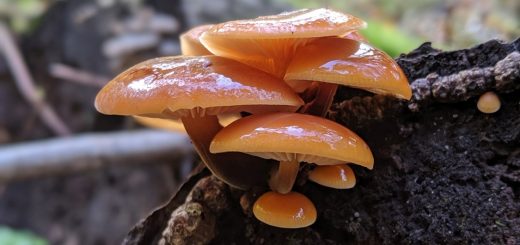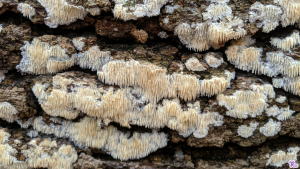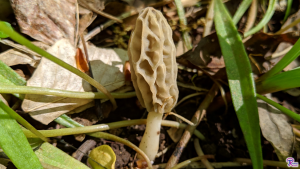#144: Stereum ostrea, the False Turkey Tail
This mushroom is a common sight on hardwood logs at any time of the year. Its fan shape and circular zones of orange and brown colors make Stereum ostrea look very similar to the true Turkey Tail, Trametes versicolor. ostrea, the “False Turkey Tail,” has a smooth undersurface, which easily distinguishes it from T. versicolor.
As its common name suggests, the False Turkey Tail looks a lot like the Turkey Tail, which is reminiscent of a tiny turkey’s tail. S. ostrea is fan-shaped and attached to its substrate at a central point. It is a medium-sized mushroom, growing 1-7cm (0.5-3in) in width and frequently producing mushrooms on the upper end of that range. The fan usually curves up, making it shaped somewhat like a half of a funnel or an upside down oyster shell (which is alluded to by the specific epithet ostrea). False Turkey Tail mushrooms are tough and leathery and are usually no more than a few millimeters thick. S. ostrea usually produces many fruiting bodies close together, but the mushrooms are usually spaced just far enough apart that they do not fuse with one another.
The upper surface displays concentric zones of color much like the pattern on a turkey’s tail. S. ostrea can have zones colored orange, brown, red, yellow, and tan. In fresh mushrooms, the rim is often white. The colors fade over time and older specimens are often shades of white and green. Green colors on False Turkey Tail mushrooms come from algae that have colonized the inactive upper surface of old mushrooms. The upper surface can be fuzzy or smooth, but in general young mushrooms are hairy and become smoother as they age. In my experience, the largest mushrooms hardly have any hairs at all.
The main difference between the False Turkey Tail and the true Turkey Tail is that the False Turkey Tail has a smooth undersurface while the underside of the true Turkey Tail is covered in tiny pores. S. ostrea is a crust fungus, meaning that it does not have pores/gills/teeth or any other modifications to its spore-producing surface. Instead, the fertile surface of S. ostrea is simply smooth. The lower surface is colored similarly to the top, but the lower surface has more muted colors and much fainter zonations.
S. ostrea can be found growing from hardwood logs in many parts of the globe. The fungus causes a white rot, meaning it primarily decays lignin and leaves behind patches of white, fibrous cellulose. S. ostrea particularly likes oak wood, but can be found on many types of hardwood. New mushrooms are produced from late spring to early winter, but the mushrooms are quite hardy and old specimens can be found throughout the year. The False Turkey Tail is widespread in North America, Europe, and Australia (and given that distribution, it is likely common in at least parts of South America, Asia, and Africa, but I could not verify this suspicion on any websites I consulted).
The mushroom most similar in appearance to S. ostrea is, of course, Trametes versicolor (the Turkey Tail). In addition to the presence of pores, T. versicolor can be differentiated by its colors and its shape. The Turkey Tail usually contains at least some dark colors on its upper surface, often including shades of dark brown, blue, and grey. Additionally, its lower surface is solid white. With experience, it is possible to differentiate between T. versicolor and S. ostrea just by looking at the mushroom’s shape. T. versicolor is flattish and often fused with nearby mushrooms while S. ostrea is shaped like an upturned oyster shell and rarely fuses with its neighbors.
There are also a few other crust fungi that appear similar to S. ostrea. S. hirsutum and S. complicatum also produce brightly-colored, zonate, shelf-like mushrooms. However, these mushrooms are usually smaller, flat, more broadly attached to their substrate, and often fused with nearby mushrooms.
Lenzites betulina (FFF#168) is also similar from above, but it has well-formed gills on its undersurface. Thanks to this fact, the “Gilled Polypore” is easy to differentiate from Turkey Tail look-alikes.
The False Turkey Tail is not used for very much. Although it is a gorgeous mushroom when fresh, it has been largely overlooked by humans. Its tough texture makes it unsuitable for human consumption, although one study found that extracts from S. ostrea had antifungal and antibacterial properties. One final interesting note on this fungus: the False Turkey Tail is often parasitized by jelly fungi, particularly those in the genus Tremella.
See Further:
http://www.mushroomexpert.com/stereum_ostrea.html
http://www.rogersmushrooms.com/gallery/DisplayBlock~bid~6791.asp
http://botit.botany.wisc.edu/toms_fungi/nov2000.html
http://www.mushroomexpert.com/trametes_versicolor.html








![#011: Characteristics of Kingdom Fungi [Archived]](https://www.fungusfactfriday.com/wp-content/themes/hueman/assets/front/img/thumb-small-empty.png)



Great information and very accurate. Most don’t even mention this mushroom. I have used it to get rid of colds. I would not recommend it’s use to those with malabsorption though because it inhibits pancreatic lipase.
The false Turkey tail has helped me to get over many colds. It’s so common, I love reading that there’s been some proven benefits. It’s all over my yard in the woods.
Interesting, I haven’t heard from anyone else who uses S. ostrea medicinally – thanks! One point of clarification: although it does produce antimicrobial compounds, there have been no “proven” health benefits from using S. ostrea (the specific antimicrobials might break down in the stomach, for example). To prove a health benefit, you need to conduct a double-blind clinical trial in humans, which has not been done for S. ostrea.